Behavioral Neuroscience Exam 2
1/94
There's no tags or description
Looks like no tags are added yet.
Name | Mastery | Learn | Test | Matching | Spaced |
|---|
No study sessions yet.
95 Terms
8 Senses
Touch
Taste
Smell
See
Hear
Movement
Balance
Interception
Somatic Sensory Info
The sensations we get from the skin, muscles, bones, and joints.
Visceral Sensory Info
The sensations from viscera ( i.e internal organs)
Somatic Sensory
Sensations can be both pleasant and unpleasant.
Visceral Sensory
Sensations are always unpleasant.
Special Sensory Info
Sight, taste, smell, hearing, and equilibrium (state of balance)
Why is the “special sensory info” special?
Rely on sensory organs like the eyes, ears, nose, and tongue to detect stimuli and convert signals.
Function of Senses
Ability to make the body aware of external and internal change. In turn permitting the CNS to produce reactions and maintain body homeostasis.
Chemoreceptors
Detect change in chemicals (think taste)
Osmoreceptors
Detect change in osmotic pressure (the amount of salt to water ratio that results in things like bloating)
Thermoreceptors
Detect change in temperature
Mechanoreceptors
Detect mechanical forces (think touch/pressure)
Photoreceptors
Detect light (think sight)
Nociceptors
Detect pain
Receptors
An entire cell that is specialized to respond to a physical/chemical stimulus and covert that stimulus into a neural (electrical) signal.
Hapis
Receptors for fine touch and pressure cause physical disturbances that result in the opening of sodium channels which leads to DEPOLARIZATION which in turn can lead to an ACTION POTENTIAL
Somatosensory System
Speed is determined by myelin and diameter.
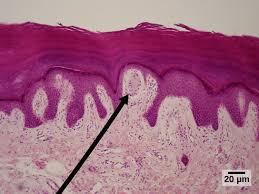
Meissner’s Corpuscles
Small, oval shaped sensory receptors located in the skin. Responsible for detecting light touch, vibrations, and fine tactile sensations.
What determines the speed of a nerve impulse?
Myelin and axon diameter. The larger the diameter the faster the conduction.
Conduction
The process of an electrical signal, called an action potential, traveling down a nerve cells axon. Think domino effect: when one part of the axon is activated, it triggers the next section and so on.
A Fibers
Fast pain
C Fibers
Aching pain
Proprioceptors and Mechanoreceptors
Peripheral somatosensory axons Group 1 and 2 have the largest diameter and the thickest myelin
Peripheral somatosensory axons Group 3
Carry sharp pain or cool/cold info and are thinly myelinated (meaning covered by myelin)
Peripheral somatosensory axons Group 4
Carry dull pain, deep pain, crude touch or warm/hot information and are unmyelinated (not covered by myelin)
DCML Tract (dorsal column medial lemniscus)
The main sensory pathway for hapsis (fine touch, vibration and proprioception)
DCML Neuron Orders & Path
Involves 3 orders of neurons: 1st Order (Skin to Medulla) → 2nd Order (Medulla to Thalamus) → 3rd Order(Thalamus to Somatosensory Cortex).
DCML Decussation (Crossing Over)
The sensory information crosses the midline (decussates) at the medulla (lower brainstem). This means sensation from the right side of the body is processed by the left brain, and vice-versa.
Fast pain
Transmitted by the spinothalamic tract
Deep pain
Transmitted by the spinoreticular tract
Dorsal (Top)
Part of the spinal cord that processes sensory
Ventral (Bottom)
Part of the spinal cord that process motor cortex
Primary Somatosensory Cortex
Located in the post central Cyrus of the parietal lobe. Lies behind the primary motor cortex of the frontal lobe. This is afferent.
Afferent
Neurons that carry information from sensory receptors found all over the body towards the central nervous system
Efferent
Neurons also called motor neurons are the nerve fibers responsible for carrying signals form the brain to the PNS
Motor cortex
Located in the frontal lobe of the brain in the posterior pre central gyrus. This is efferent.
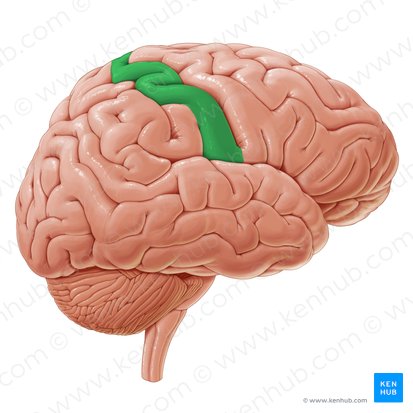
Gyrus
Ridge like elevation found on the surface of the cerebral cortex.
Apraxia
A disorder of the brain and nervous system in which a person is unable to perform tasks of movements when asked.
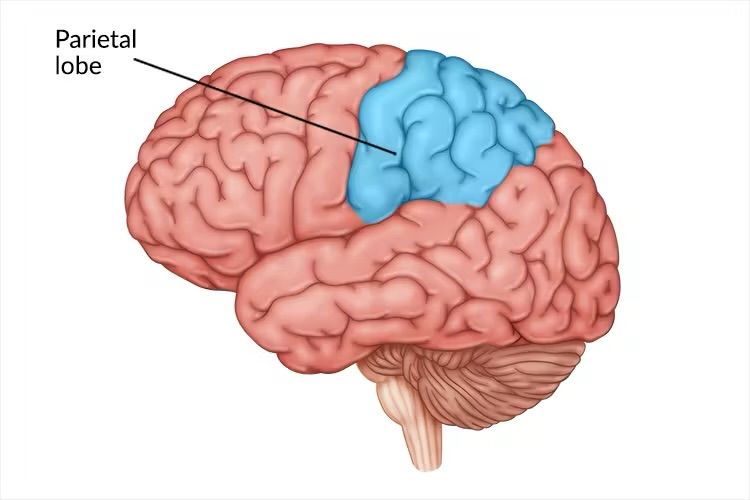
Posterior parietal cortex
An area of the brain associated with planning movements and spatial awareness.
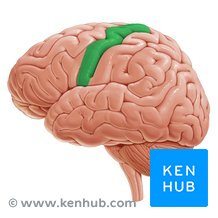
Pre central gyrus
Sends commands to execute the movements. Motor cortex.
Descending motor pathways
Groups of myelinated nerve fibers that carry motor info from the brain or brain stem to muscles via the spinal cord. Left controls right, right controls left.
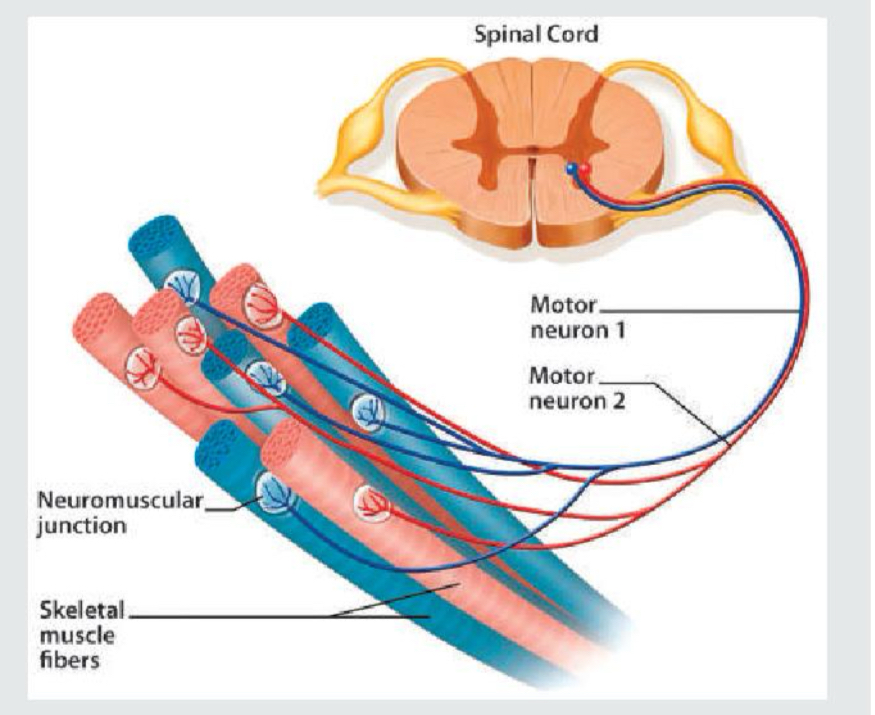
Motor Unit (Lower Motor Neurons)
A single spinal motor neuron and all of the individual muscle fibers it contacts.
ALS
Disease of the motor neurons in which both UMS and LMN gradually deteriorate and then die.
Lower motor units (LMN)
Found in the spinal cord (from neck to feet) or brainstem (feet)
Upper motor neurons
Originate in the cerebral cortex and travel down to the brain stem or spinal cord.
Corticobulbar tract
A neural pathway from the cerebral cortex to the brainstem, controlling voluntary movements of the face, head, and neck muscles.
The reflex
The simplest interaction between sensory and motor systems
The stretch reflex
Helps us maintain a limbs position in space against a sudden, unexpected load.
Withdrawal reflex
Touch something painful and you immediately pull away. Motor neurons fire to contract muscles based on sensory information from the skin.
Basal Ganglia
Brain structures that control muscle movements.
Substantial nigra
A part of the midbrain, located in the brainstem. Involved in movement and reward
Anosmia
Loss of sense of smell
Dysgeusia
Loss or alteration of sense of taste
Olfaction
the sense of smell is the response to chemicals that contact the membranes inside the nose
Odorants
chemicals that activate transduction processes in neuron
Cribriform plate
Thin sheet of bone through which small clusters of axons penetrate, coursing to the olfactory bulb
Glomeruli
Primary processing units for processing smell in olfactory bulb. Enable brain to spatially discriminate between many odors spatially.
Why might it be important to detect relatives’ scent?
Odor may influence mate choice to avoid genetic inbreeding
Pheromones
Secreted chemical factor that triggers a social response in members of the same species. Types include sex, alarm, and food trail.
Taste
Provides an assessment of foods. Specialized tongue receptors encode 5 distinct tastes • Salty, sour, bitter, sweet, umami
Taste buds
Tiny sensory organs that detect dissolved chemicals in food and transmit signals to brain for your perception of taste. Located in the small bumps of your tongue called papillae
Gustation
Tastants bind to corresponding receptors on taste cell • Activation of many different G proteins, which release Ca++ inside • Triggers neurotransmitter release and primary sensory fires an AP to gustatory system in brain
Gustatory cortex
A taste ”map” is preserved in the gustatory cortex like sensory and motor systems • Within the frontal lobe and contains part of the insula cortex • Involved in taste perception, flavor discrimination and taste guided behaviors
Conditioned taste aversion (CTA)
Aversive experiences with a certain food can change our evaluation of its taste.
Audition
The physical stimulus are vibrations of air molecule.
Sine waves
Smooth s shaped waveform defined by mathematical sine function. Represents an oscillation (central line) and is obsevered in sound,light, and electrical signals.
Pinna
Captures and amplify vibrations in the air. Outer visible part of the ear.
Tympanic membrane (Eardrum)
Sound waves travel down the auditory canal and impact this.
The ossicles
Three small bones on the other side of the tympanic membrane. Movement of the tympanic membrane moves the bone.
What vibrates the tympanic membrane?
Sound
What happens when sound vibrates the ossicles?
Sound causes the stapes (stirrup) to vibrate the oval window of the cochlea.
What is the cochlea?
Fluid filled spiral with inner finger like structures called the organ of corti (sense organ of audition)
Organ of corti
Convert sound vibrations into electrical signals that are transmitted to the brain for interpretation
Hair cells
Special sensory receptors of the inner ear. Modified epithelial cells that act as Mechanoreceptors.
Tonotopic maps
Regions that respond best to one particular tone will be neighbored by regions that respond best to a tone of a slightly different frequency
Medial geniculate nucleus
Region of the thalamus that processes auditory info
Primary auditory cortex location
Located within the temporal lobe of the cortex
Responsibility of the primary auditory cortex
The initial processing of auditory information including the perception of sound features like pitch, volumes, and ray themes.
Higher Order Processing
parallels with visual system
What is essential to vision?
Light - without light there can be no visual perception.
How can light be characterized?
Similar to sound, it can be characterized as a sine wave
Wavelength
Color
Amplitude
Brightness
Retina
Contains the sense organs for vision. Its where the physical stimulus is converted into a neural signal
Where does light enter through?
The pupil - the iris’s dictates the opening of the pupil and in bright light the pupil constricts and in dim light the pupil dialates
What nervous system leads to pupil dilation?
Sympathetic
What nervous system leads to pupil constriction?
Parasympathetic
Sensitivity
The larger the pupil size, the more light permitted in
Acuity
In bright light, the pupil constricts. This way you can see things sharper
Lens
Focuses incoming light (permitted by the pupil)
What part of the eye is composed of 5 layers of neurons?
The retina - the five layers are receptors, horizontal cells, bipolar cells, amacrine cells, and retinal ganglion cells.
What is the solution to the problem that light is filtered and distorted on its way through the neuronal cell layers to the receptors?
Fovea - a specialized area of the retina with a thinning of the retinal ganglion cell layers.
Rods
Dominates in dim light. Sensitive to light, poor acuity, lack of color, referred to as scotopic vision
Cones
Dominated in ample light. High acuity, color, referred to as phototopic vision